List of Authors
>>About this blog
Recent blog post
|
[Nojinya]
Nov. 10, 2015 09:00
A monument to "the birthplace of seafarer education" is built on Eitai Bridge Nishizume at Shinkawa 2-chome. 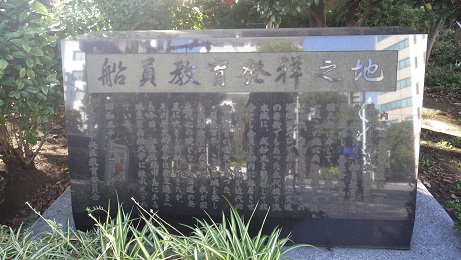 140 years ago, on November 1, 1875, Mitsubishi Shosen School, the predecessor of Tokyo Shosen School (now the Faculty of Marine Science and Technology, Tokyo University of Marine Science and Technology) was established. 140 years ago, on November 1, 1875, Mitsubishi Shosen School, the predecessor of Tokyo Shosen School (now the Faculty of Marine Science and Technology, Tokyo University of Marine Science and Technology) was established.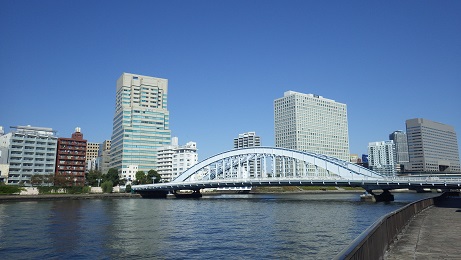
At that time, Japan's shipping industry was delayed due to the isolation of the country that lasted for more than 250 years, and the operation of major ocean-going vessels relied on foreign seafarers. In order to improve the appearance of a modern nation, the Meiji New Government considers it urgent to operate international routes by Japanese people, and ordered Yataro Iwasaki of the Mitsubishi Zaibatsu under the order of the Minister of Internal Affairs Toshimichi Okubo, A full-fledged high seafarer education began with the sailing ship Narumimaru moored on the Okawa side of the school building and practice boat.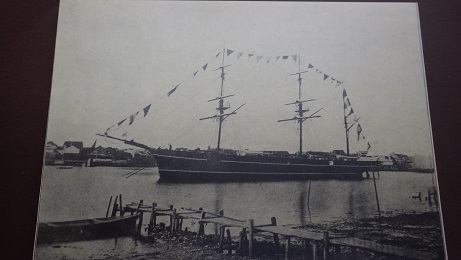
[School Funari Myomaru (1875) provided by the 100th Anniversary Museum of Tokyo University of Marine Science and Technology]
The Mitsubishi Shosen School, which was established on Reigishi Island, was later transferred to the government and became Tokyo Shosen School, and is now being handed over to the Tokyo University of Marine Science and Technology's School of Marine Science and Technology in Echinakajima, Koto-ku, across the Sumida River.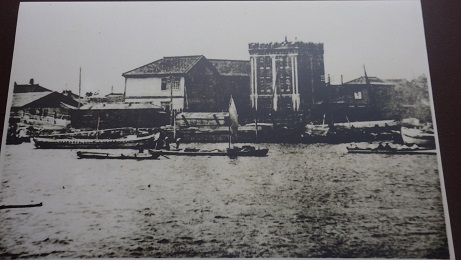
100th Anniversary Museum of Tokyo University of Marine Science and Technology (Tokyo University of Marine Science and Technology)
Toshimichi Okubo ordered Yataro Iwasaki to create a merchant ship school, but the headquarters of the Mitsubishi Steamship Company (established in 1870), which took over the business of the Tosa Domain, was located in Nihonbashi Minami Kayabacho (in 1874), and the company went to Tokyo, Osaka, Kochi, etc. ⇔headwater.
If you walk from Eitai Bridge to Shinkawa Park, Chuo-ohashi Bridge, and Ishikawajima Park, you will reach Aioi Bridge. There is a museum commemorating the 100th anniversary of Tokyo University of Marine Science and Technology on Ecchu Island in Koto-ku across the bridge. There is a permanent exhibition (ship engine, ship model, signal flag, rope work, etc.), and you can also climb on the deck of Meiji Maru. The photo shows Mr. Mori of Tokyo Shosen University OB, a volunteer of the Memorial Museum who guided me.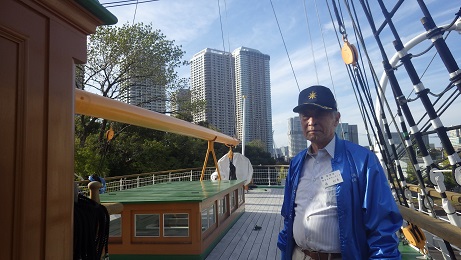
At the Memorial Museum, special exhibition is holding "Meiji Opened by Ships: The 140th Anniversary Exhibition of Merchant Ship Education: People raised ships and ships raised people" until November 30. Photos related to Mitsubishi Shosen School in the text were released for a limited time at the exhibition, and were provided by the courtesy of the 100th Anniversary Museum of Tokyo University of Marine Science and Technology.
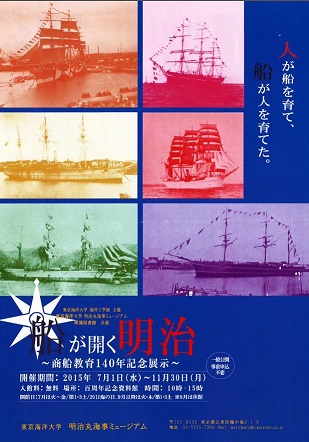
The Memorial Archives are located in Echinakajima, Koto-ku, but this is a good opportunity to learn about the history of Mitsubishi Shosen School, which was established on the opposite bank of Reigishima Island (now Shinkawa, Chuo-ku). Why don't you extend your feet while thinking about the history of the waterfront in Chuo-ku from the monument of the birthplace of seafarer education at Eitai Bridge Nishizume?
[The Monument of the Birthplace of Seafarer Education]
Location 1-30 Shinkawa, Chuo-ku (Eitai Bridge Nishizume / Eitai-dori St. South Sidewalk)
(5-minute walk from Kayabacho on the Hibiya Line and Tozai Line)
100th Anniversary Museum of Marine Science and Technology, Tokyo University of Marine Science and Technology
〒135-8533 2-1-6, Echinakajima, Koto-ku 135-8533 100th Anniversary Museum of Echinakajima Campus Tokyo University of Marine Science and Technology
(Approximately a 10-minute walk from Tsukishima Station on the Yurakucho Line and Oedo Line)
Opening hours: 1000-1500 (Tuesday / Trees / 1st and 3rd soil only open)
Admission fee: Free of charge
TEL; 03-5245-7360 (Meiji Maru Maritime Museum)
[Nojinya]
Nov. 4, 2015 09:00
It's getting colder day by day. There are many days when I return home late at night, but after a long absence, I decided to have dinner with a friend working in Ningyocho. Because of the warm seasonal pattern, I decided to eat "leek manave" at the suggestion of a friend. Well, in fact, I haven't heard about this dish until I was invited by a friend this time, and what is "Negima" using the meeting time? I checked it.
Then, a story about rakugo called "Negima no Tono" comes out. This is a story that the 5th generation Kokontei Imasuke, a rakugo artist, was good at.
≪The lord, who took his servant and went out to the snow viewing of Mukaijima, was caught by the smell of a boiled shop lined up in Hirokoji (Ueno) while the north wind of Tsukuba grated in midwinter blows, and said that it was a lower food. When I didn't listen to the voice of the servant, I sat in a soy sauce barrel and eat a tuna pot. The small pot, which came out in front of the palace where "Negima" was heard as "Nya ~" in the early mouth of a monk at the store, contains green onions in a slice of tuna mixed with bones and blood, and looks like a three-colored cat. If you eat it, the core of the green onion jumps in your mouth like a gun.
The lord who returned to the mansion wants to eat that "Nya-", and Rutayu (culinary clerk) can't hear what "Nya-" is, but listens to the story from Santayu. I understand that it is a green onion pot.
However, it is not possible to give the food of the common people to the lord as it is, and if the tuna and green onions are carefully prepared, the lord is completely convinced that "this is not a Nya". Rutayu can't help but recreate pigtails with ingredients similar to green onions and boiled shops. The lord was very happy and said, "Rutayu, it's not fun to sit down. I have a soy sauce barrel."≫
My friend has arrived here, so I will go through the Geisha Shindo next to Daikanonji and head to the Yoshi Umemoto store.  Geisha Shindo retains the former Geisha Okeya in Hanamachi, and the streets such as Kikuya and Yoshiume, a model of "Matsuya" in the drama "Shinjin", create the Edo atmosphere. When you enter the store while stepping on the paving stones, you will be guided to a parlor where the structure of the former hut remains as it is. Geisha Shindo retains the former Geisha Okeya in Hanamachi, and the streets such as Kikuya and Yoshiume, a model of "Matsuya" in the drama "Shinjin", create the Edo atmosphere. When you enter the store while stepping on the paving stones, you will be guided to a parlor where the structure of the former hut remains as it is.
Yoshiume, who lived in Yoshicho, was founded in 1927, so it is called "Yoshiume", and as expected, wild dishes such as "Don-sama" tasted at Hirokoji did not come out However, I warmed up with a tuna and green onion just "Negion hot pot".
 In addition to the main store we visited this time, there is Yoshiume Yoshicho-tei on the same geisha Shindo, which was designated as a registered Tangible Cultural Property and was also the residence of actress Kogiku Hanayagiku. In addition to the main store we visited this time, there is Yoshiume Yoshicho-tei on the same geisha Shindo, which was designated as a registered Tangible Cultural Property and was also the residence of actress Kogiku Hanayagiku.  [Yoshi Umemoto store] [Yoshi Umemoto store]
〒103-0013 Ningyocho, Chuo-ku 1-18-3
TEL: 03-3668-4069
Business hours 1700~2200(LO:2100。 Lunch is also open and closed on weekends and holidays.
[Nojinya]
Nov. 3, 2015 12:00
I'm going to the barber shop that I always go to because my hair is growing soon. The location is "Ginza Ins 3" which I introduced in my blog before. 。 。
Yes, it is a shopping street under Tokyo Kosoku Doro that goes around Ginza. This is unique in terms of shopping streets under the highway, but the tenants inside also have attractive shops such as "Japone (/archive/2015/08/post-2652.html)" introduced last time. This time, I would like to talk about the barber shop in Ginza Ins 3 and the phantom town name "Ginza Nishi 1-chome" as the third installment of "Tokyo Kosoku Doro".
Open the glass door at the entrance of Ginza Inns 3 above Ginza 1-chome Station on the subway Yurakucho Line and enter inside. When you go through the side of a tailor with the atmosphere of Showa and enter the back, you will see a rotating pole with red, white, and blue stripes. 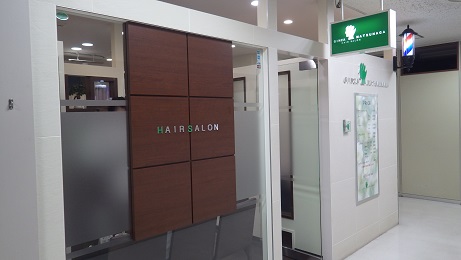 The name of the shop is "Ginza Matsunaga Yurakucho Store". Some of you may have questions after reading so far, so please give me a little supplementary explanation. This is the Yurakucho store, but the place is in Chuo-ku. Ginza Ins 3, where the Ginza Matsunaga Yurakucho store is located, is located just above the border between Chuo-ku and Chiyoda-ku because it was originally built by reclaiming the outer moat (river). In fact, because the administrative divisions are unclear, it is still an unusual address called "Ginza Nishi 1-chome 2nd place (Saki)". Currently, the display of residences in the Ginza district is integrated into Ginza 1-8 chome, but these were once divided into place names such as Ginza Nishi, Ginza, and Ginza Higashi (formerly Kibikicho). The name of the shop is "Ginza Matsunaga Yurakucho Store". Some of you may have questions after reading so far, so please give me a little supplementary explanation. This is the Yurakucho store, but the place is in Chuo-ku. Ginza Ins 3, where the Ginza Matsunaga Yurakucho store is located, is located just above the border between Chuo-ku and Chiyoda-ku because it was originally built by reclaiming the outer moat (river). In fact, because the administrative divisions are unclear, it is still an unusual address called "Ginza Nishi 1-chome 2nd place (Saki)". Currently, the display of residences in the Ginza district is integrated into Ginza 1-8 chome, but these were once divided into place names such as Ginza Nishi, Ginza, and Ginza Higashi (formerly Kibikicho). 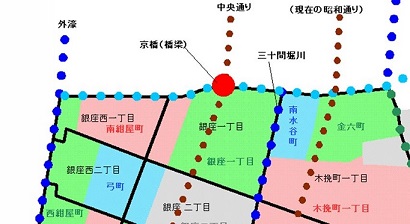 [Source:: From wikipedia, "New and Old Town Name Comparison Map before and after the Earthquake Reconstruction (Ginza District)" [Source:: From wikipedia, "New and Old Town Name Comparison Map before and after the Earthquake Reconstruction (Ginza District)"
The place name Ginza Nishi 1-chome was originally Minami Konya-cho, from the west side of Ginza Gaslight Street to Sotobori-dori St. in Ginza 1-chome. When it was the name of Nishikonyamachi, it was changed to Ginza Nishi 1-chome in 1930, and it was integrated into Ginza 1-chome due to the change of residence display in 1968, and it became Ginza 1-chome. As a result, the name of Ginza Nishi 1-chome seemed to have disappeared, but thanks to Tokyo Kosoku Doro, it has remained exceptional until now.
I will return to the story of Ginza Matsunaga. When you open the door and enter inside, it turns around and is a clean and stylish space separated by wood grain-tone partitions under bright lighting. Because I'm close to the company, I go here regularly, but there are many options, as well as the hairdresser's promise cut, shampoo, shaving, and shoulder fir. Not only high technology, but also polite and friendly response is very comfortable and you can enjoy a blissful time. The photo is Mr. Ozawa, a stylist who always takes care of me.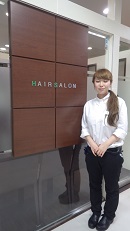
Ginza Matsunaga has been 47 years since it opened in Ginza in 1968, as the name suggests. Currently, there are 18 stores in addition to 3 stores in the Ginza area. It is a global barber shop that expands overseas and supports the lives of Japanese people who work hard in Germany and Vietnam.
The Yurakucho store is located in a convenient place to stop by on the way back from the silver bra, but this is also close to the office district and it is quite crowded in the evening, so it may be better to make a reservation in advance.
[Hair Salon Ginza Matsunaga Yurakucho Store]
〒104-0061 Ginza-Nishi 1-chome, Chuo-ku Ginza-Nishi 1-chome, Ginza Ins 3 1F
(Now Exit 1 of Ginza 1-chome Station on the Yurakucho Line)
TEL: 03-3567-3887
Business hours 1030-2000 (until 1900 on weekends and holidays)
[Nojinya]
Nov. 2, 2015 10:00
I noticed that it was already November. In the daytime  when the sun is sunny, you can still enjoy walking around the city, but the sunset time is much faster and it is a long night of autumn. It was a fun season to return home early and read when the sun is sunny, you can still enjoy walking around the city, but the sunset time is much faster and it is a long night of autumn. It was a fun season to return home early and read after eating. This time, as the third installment of "Chuo-ku to enjoy in literature", we will introduce "Angry Fuji" (written by Jiro Nitta), in which Kanto-gun Dai Ina Hanzaemon Tadajun (Tadanobu) plays an active role as the main character. after eating. This time, as the third installment of "Chuo-ku to enjoy in literature", we will introduce "Angry Fuji" (written by Jiro Nitta), in which Kanto-gun Dai Ina Hanzaemon Tadajun (Tadanobu) plays an active role as the main character.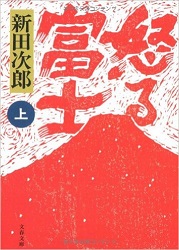
The period was the Hoei era in the middle of the Edo period (1704-1710). As can be seen from the title, it begins on November 23, 1707, when Mount Fuji exploded. The eruption lasts for 17 days, and the foot of Mt. Fuji is buried with falling sand and volcanic ash, making it difficult for farmers not only to cultivate fields but also to continue living. Under such circumstances, Hanzaemon Ina of Kanto-gun will be responsible for cleaning up the damage caused by the great explosion on Mount Fuji. Hanzaemon struggles to save farmers with high morals, but the peasants' plights elsewhere and the bureaucrats of the Shogunate who struggle to overcome power struggles have caused the funds to be washed away and reconstruction is difficult. . Hanzaemon can't see such a situation, and will open Yonekura in the Shogunate's Sunpu (now Shizuoka City) and distribute it to the hungry of disaster area. As a result, he is said to take responsibility for this illegal act.
It is difficult to understand just by hearing the duties of Kanto-gundai, but it is said that he was the best family of Tokugawa shogunate's deputy, ruled Kanpachishu and had the power to surpass the daimyo. Since the first Tadatsugu Ina, he has served the Tokugawa family for generations as a practical bureaucrat in charge of civil engineering technology such as river renovation of the Tone River and Arakawa River, and Hanzaemon Tadajun is the seventh generation (the Ina family's Kanto-gun representative is the house turmoil Until the 12th Tadason was rebuilt in 1792). The novel focuses on the story of the cleanup of the Mount Fuji explosion of Hanzaemon, but Hanzaemon's achievements are rather common in Edo, and the bridge of Eitai Bridge commemorating the 50th birthday of the 5th Shogun Tsunayoshi (1698), Fukagawa, Honjo, Asakusa River, and other flood control-related works are being carried out in Asakusa Ward, and the current residence in Kanto-gun. 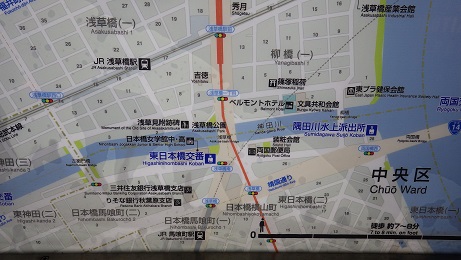 In the novel, reconstruction after the eruption of Mount Fuji is the center of the story, so there are many scenes such as Sunpu and Sako, but Bakurocho's official residence will appear in situations such as communication with the Shogunate and paperwork. Why don't you think about Asakusabashi in the Edo period in a novel on the long night of autumn? In addition, there is a commentary version of the Gundai mansion next to the Higashinihombashi police station in Asakusabashi Minamizume, and a monument to the site of Asakusa Mitsuke is built on Kitazume (Taito Ward side). In the novel, reconstruction after the eruption of Mount Fuji is the center of the story, so there are many scenes such as Sunpu and Sako, but Bakurocho's official residence will appear in situations such as communication with the Shogunate and paperwork. Why don't you think about Asakusabashi in the Edo period in a novel on the long night of autumn? In addition, there is a commentary version of the Gundai mansion next to the Higashinihombashi police station in Asakusabashi Minamizume, and a monument to the site of Asakusa Mitsuke is built on Kitazume (Taito Ward side).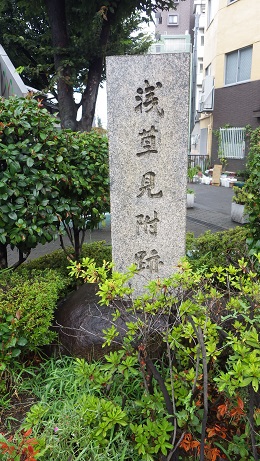
[Remains of Gundaiyashiki]
Location: 2, Bakurocho, Chuo-ku
Access A 2-minute walk from JR Bakurocho Station and a 5-minute walk from Asakusabashi Station on the JR Toei Asakusa Line.
(There is a commentary board of "Gundai Yashiki Ruins" next to Higashinihombashi Police Station.)
1
|
Links
|
 140 years ago, on November 1, 1875, Mitsubishi Shosen School, the predecessor of Tokyo Shosen School (now the Faculty of Marine Science and Technology, Tokyo University of Marine Science and Technology) was established.
140 years ago, on November 1, 1875, Mitsubishi Shosen School, the predecessor of Tokyo Shosen School (now the Faculty of Marine Science and Technology, Tokyo University of Marine Science and Technology) was established.




 Geisha Shindo retains
Geisha Shindo retains

 [Yoshi Umemoto store]
[Yoshi Umemoto store] The name of the shop is "Ginza Matsunaga Yurakucho Store". Some of you may have questions after reading so far, so please give me a little supplementary explanation. This is the Yurakucho store, but the place is in Chuo-ku. Ginza Ins 3, where the Ginza Matsunaga Yurakucho store is located, is located just above the border between Chuo-ku and Chiyoda-ku because it was originally built by reclaiming the outer moat (river). In fact, because the administrative divisions are unclear, it is still an unusual address called "Ginza Nishi 1-chome 2nd place (Saki)". Currently, the display of residences in the Ginza district is integrated into Ginza 1-8 chome, but these were once divided into place names such as Ginza Nishi, Ginza, and Ginza Higashi (formerly Kibikicho).
The name of the shop is "Ginza Matsunaga Yurakucho Store". Some of you may have questions after reading so far, so please give me a little supplementary explanation. This is the Yurakucho store, but the place is in Chuo-ku. Ginza Ins 3, where the Ginza Matsunaga Yurakucho store is located, is located just above the border between Chuo-ku and Chiyoda-ku because it was originally built by reclaiming the outer moat (river). In fact, because the administrative divisions are unclear, it is still an unusual address called "Ginza Nishi 1-chome 2nd place (Saki)". Currently, the display of residences in the Ginza district is integrated into Ginza 1-8 chome, but these were once divided into place names such as Ginza Nishi, Ginza, and Ginza Higashi (formerly Kibikicho).

 In the novel, reconstruction after the eruption of Mount Fuji is the center of the story, so there are many scenes such as Sunpu and Sako, but Bakurocho's official residence will appear in situations such as communication with the Shogunate and paperwork. Why don't you think about Asakusabashi in the Edo period in a novel on the long night of autumn? In addition, there is a commentary version of the Gundai mansion next to the Higashinihombashi police station in Asakusabashi Minamizume, and a monument to the site of Asakusa Mitsuke is built on Kitazume (Taito Ward side).
In the novel, reconstruction after the eruption of Mount Fuji is the center of the story, so there are many scenes such as Sunpu and Sako, but Bakurocho's official residence will appear in situations such as communication with the Shogunate and paperwork. Why don't you think about Asakusabashi in the Edo period in a novel on the long night of autumn? In addition, there is a commentary version of the Gundai mansion next to the Higashinihombashi police station in Asakusabashi Minamizume, and a monument to the site of Asakusa Mitsuke is built on Kitazume (Taito Ward side).

